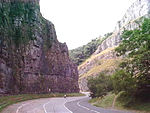Cheddar railway station
1869 establishments in EnglandCheddar, SomersetDisused railway stations in SomersetFormer Great Western Railway stationsPages with no open date in Infobox station ... and 3 more
Railway stations in Great Britain closed in 1963Railway stations in Great Britain opened in 1869Use British English from March 2017

Cheddar railway station was a station on the Bristol and Exeter Railway's Cheddar Valley line in Cheddar, Somerset, England. The station had substantial goods traffic based on the locally-grown strawberries, which led to the line's alternative name as The Strawberry Line.
Excerpt from the Wikipedia article Cheddar railway station (License: CC BY-SA 3.0, Authors, Images).Cheddar railway station
Perry's Close, Sedgemoor
Geographical coordinates (GPS) Address External links Nearby Places Show on map
Geographical coordinates (GPS)
| Latitude | Longitude |
|---|---|
| N 51.2757 ° | E -2.7841 ° |
Address
Old Cheddar Station
Perry's Close
BS27 3DU Sedgemoor
England, United Kingdom
Open on Google Maps







